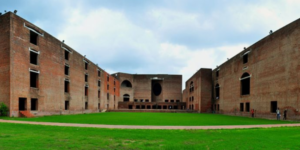When India celebrated 75 years of Independence in 2022, a key indicator of development that was scrutinised closely was the state of healthcare. The country has made considerable progress in raising life expectancy at birth, expanding immunisation coverage, and reducing infant mortality. The prevalence of infectious diseases such as malaria, tuberculosis, and diarrhoea has also fallen. Mental health legislation now protects the rights of neglected groups.
Yet, India scores lower than neighbouring Bangladesh, Maldives, Bhutan, and Sri Lanka on life expectancy. Indian citizens have not been able to make the right to health a political priority. In 1946, the colonial government produced the Bhore Committee report, which said no one should be denied adequate medical care because of an inability to pay, and health services should provide all consultant, laboratory, and institutional facilities.
Absence of a justiciable right to health has eased the pressure on governments to provide universal health coverage, address social factors that determine good health – such as good housing and a clean environment – and, crucially, eliminate the impoverishing out-of-pocket expenditure (OOPE) imposed on households.
OOPE data from the national health accounts estimates for 2018–19, which the union government continues to cite, show that it stood at 48.2% of total health expenditure, or 1.52% of gross domestic product (GDP). For catastrophic expenditure, treatment of cardiovascular diseases in private hospitals was the single biggest category reported by 84% of households.
The courts have held the right to health to be a fundamental right under Article 21, and reinforced this often enough to make treatment available to many. Healthcare is recognised as an extension of the right to life by the Supreme Court. Most recently, in January 2023, the apex court said by a four to one order that Articles 19 and 21 could be enforced against “persons other than the state and its instrumentalities.”
India is a signatory to the United Nations’ Sustainable Development Goals, which require governments to achieve health for all by 2030.
A rights-based framework for health would result in appropriate allocation of resources to achieve the goal, and raise accountability standards. Successive governments in New Delhi have baulked at making the right to health justiciable, relying instead on incremental expansion of health coverage, relying mainly on for-profit institutions and insurance models.
The National Health Policy, 2017 made an elaborate argument to justify its stand that the time had not come for declaring health as a right . It advocated “a progressively incremental assurance-based approach, with assured funding to create an enabling environment for realising health care as a right in the future”, essentially kicking the can down the road.
Contrary to this evasive approach, the new Right to Health Act in Rajasthan shows transformative potential by explicitly guaranteeing access to health for the state’s residents. The law passed by the Congress government led by Chief Minister Ashok Gehlot on 21 March 2023 is based on moral and legal imperatives. It provides for dispute resolution, and constituting district and state authorities to rule on complaints. It also prescribes fines for violations, making a beginning on accountability for health institutions.
In its preamble, the Rajasthan act says the state aims “to provide protection and fulfilment of rights and equity in health and well-being under Article 47 of the Constitution of India and to secure the Right to Health as per the expanded definition of Article 21 of the Constitution” and also to provide for “free, accessible to, and equality in, health care for all residents of the State with the progressive reduction in out-of-pocket expenditure”.
It acknowledges that good health is influenced by other factors. “The right to health is an inclusive right extending not only to timely health care but also to the underlying socio-economic, cultural and environmental [factors],” it says.
The law guarantees that those ordinarily resident in Rajasthan can avail themselves of emergency treatment without prepayment of fees or charges. This includes prompt and necessary emergency medical treatment and critical care, and emergency obstetric care. Free outpatient and in-patient treatment, drugs, diagnostics, emergency transport, procedures, and emergency care in public health institutions are covered.
The state’s move has provoked a backlash from some sections in Rajasthan, including doctors who have the support of the Indian Medical Association (IMA). Ironically, these doctors have attacked the new law as “draconian, undemocratic and anti-people” though it entitles citizens to free treatment at the point of care, especially in an emergency.
The persistent hostility to the act has resulted in fresh assurances from the government that small private hospitals and those that did not claim subsidies and concessions would not be considered as notified health establishments. Doctors have claimed the government’s announcement on 4 April to be a victory. To some activists, the right to health law has been struck a severe blow.
State reimburses costs
Much of the discussion on the act is centred on Section 3, dealing with “Rights to Health”. Doctors are mainly opposed to Section 3(c). This entitles every resident of Rajasthan to emergency treatment and care for accidental emergency, for snakebite or animal bite, and any other emergency decided by the state health authority, without prepayment of fees or charges.
Such treatment covers prompt and necessary emergency medical treatment and critical care, and emergency obstetric treatment in any public health institution. In a medico-legal case, “no health care provider or health care establishment shall delay treatment merely on the grounds of receiving police clearance or a police report.”
Further, where the patient does not pay for the treatment, the healthcare establishment would be reimbursed by the state government. Under Section 3(d), all residents of Rajasthan have the right to avail themselves of free healthcare services from public health institutions, healthcare establishments and designated healthcare centres, as laid down in the rules. More clarity on the payment system will emerge in the rules, given that there is already a universal health insurance system in Rajasthan.
The new law was welcomed by the Jan Swasthya Abhiyan (JSA), an umbrella group of civil society organisations campaigning for the right to health, with a call to the Rajasthan government to clearly define emergency treatments, set obligations for hospitals on the basis of their capabilities, and institute a transparent mechanism for the reimbursement of costs to these institutions (that is, without corruption and delays).
Special interests
The Rajasthan government has gone out of its way to accommodate special interests opposed to the Act – by excluding some text found in early drafts and introducing changes proposed by a select committee. That includes, for instance, dropping the reference to “health care provider, establishment or facility, including private provider, establishment or facility” in favour of “public health institution, health care establishment and designated health care centres.”
Section 3 contains other empowering features, such as access to patient records, investigation reports, and detailed itemised bills, as well as information on the name, professional status, and job chart of the person providing healthcare. There is also information about the rates or charges for each type of service provided and the facilities available, and freedom to choose the source of medicines or tests at all healthcare establishments. Then there is the right to be heard in case any grievance occurs during and after obtaining healthcare services.
In case of accidents, the law provides for free transportation, free treatment, and free insurance coverage against road accidents at all healthcare establishments. At the same time, it tempers expectations by explaining that it would be according to the level of healthcare in the institution one has gone to.
The opposition to the act from a section of doctors got the IMA’s endorsement. Their hostility was focused on the clause that authorises emergency treatment with no prepayment. They claimed that the state was shifting its responsibility to private medical establishments. Although the law is clear on reimbursing the private establishments, the protesting doctors see no funding pathway.
Section 5 states that the state government will “mobilise resources and frame plans or policies to carry out obligations under this Act.” The state government must now identify a budgetary route to funding the right to health and preparing the human resources for the public system.
In other progressive features, Section 5(j) provides for coordination amongst government departments to make nutritionally adequate and safe food available to patients, in addition to safe drinking water, and sanitation. Section 5(k) provides for effective measures to prevent, treat, and control epidemics and other public health emergencies.
Role of new authorities
Why should doctors oppose the right to health when the law states that they will not suffer financial losses? Is it moral for doctors to oppose the financial protection for health offered to citizens as a right?
Some unstated reasons for private establishments to oppose the law may have to do with its other provisions on regulation. The Rajasthan act provides for forming two independent state health authorities. One of these will deal with logistical grievances and the other with treatment protocols. These authorities should be able to help strengthen health-building policies across the board.
The authority on logistical grievances will advise the government on state health goals and get these included in panchayati raj institutions, assist it with strategic planning and action for healthy food, water, sanitation and epidemic control, and decide appeals against decisions of the district health authorities. It will also ensure quality and cost-effective services by the “health sector” (a reference to “private” here was dropped, as recommended by the select committee).
The second authority on treatment protocol will advise the government on any matter relating to preventive, curative, and rehabilitative medicine, and the social determinants of health. It will ensure effective, cost-effective treatments by the health sector, and hear appeals against orders of the district authorities on treatment protocols.
It must be noted that while providing for these authorities, the government deferred to the IMA and dropped the text on having two government-chosen nominees. Instead, there will be nominees from the IMA. Traditional Indian systems of medicine have also been accommodated.
The government similarly retreated in the case of the district health authorities, accepting two IMA members rather than state government nominees. Even with direct representation in these panels, some sections of the for-profit health sector remained bitter as they would have to deal with statutory panels hearing complaints related to establishments and healthcare providers under the Grievance Redress Mechanism (Section 11 of the act).
The state health authorities must meet at least once in six months and the district health authority must decide grievances within 30 days, with the appeals to be heard by the state authority. Healthcare institutions must themselves resolve complaints in three days, failing which they would be forwarded to the district health authority.
Memories of Britain
The hostility of the IMA-supported doctors to a rights-based law echoes the experience of setting up the National Health Service (NHS) in the United Kingdom. Between the world wars, Britain focused on health insurance (introduced in 1913 by Lloyd George) rather than a health service, with doctors citing many arguments to preserve the status quo.
The status quo was workers paying to get medical attention, the exclusion of wives and dependents, severe restrictions on benefits, income limits for inclusion, high out-of-pocket spending that resulted in financial ruin, concentration of doctors in urban centres, a limited voluntary sector, and local authorities struggling to provide care for the chronically and mentally ill.
Faced with the compulsion of World War II, and growing calls for a radical shift from the socialist medical association, the conservatives and the British Medical Association (BMA) proposed reform. The BMA favoured preserving private fees, adding a capitation fee for public patients, and a basic salary with additional compensation for specialist qualifications. This view was challenged by the Beveridge Report in 1942, which proposed “a national service for the prevention and cure of disease and disability” as part of a broader social security framework.
The intense struggle for dominance between BMA hardliners on the one hand and Britain’s post-war health minister Aneurin Bevan of the Labour party on the other was witnessed in the struggle to pass the bill for an NHS. The idea won with 97% of the population enrolling in the new state-run system, which also attracted 90% of the general practitioners. There were some lacunae and deficiencies when it launched on 5 July 1948, as supporters acknowledged, but the NHS has endured. The dramatic story is narrated by Michael Foot in his biography of Bevan.
Rajasthan’s Right to Health Act faces hostility from sections of doctors although it is not in the mould of Bevan’s NHS, which subsumed private practice, voluntary and municipal hospitals. The right to health law does simplify the health system, removing the uncertainties that the economist Kenneth Arrow wrote about in the American Economic Review six decades ago. The medical care market, where people face unpredictable risk, provides a product at a price that the consumer has little advance knowledge about, according to Arrow. The results are unpredictable, and when the market fails, the expectation is that the government will step in as a guarantor. Medicine has made big strides since, but uncertainties remain strong and financial protection weak.
Minor penalties
Rajasthan’s Right to Health Act is a pioneering effort to address uncertainties and risks. The penalties prescribed under the new law are minimal, involving only fines of up to Rs 10,000 for the first violation, going up to Rs 25,000 for repeat violations. If the experience with the Right to Information Act is any indication, such fines are rarely imposed, although the citizen’s case often succeeds.
Unlike the 2017 National Health Policy that confines itself to platitudinous references to the right to health, the Rajasthan law makes it actionable. It has the potential to be strengthened in the future.
The National Health Policy merely “envisages” universal access to good quality healthcare through “increasing access, increasing affordability by lowering the cost of healthcare delivery and equity.” It says further that the policy “envisages the attainment of the highest possible level of health and well-being for all at all ages, through a preventive and promotive healthcare orientation in all developmental policies, and universal access to good quality healthcare services without anyone having to face financial hardship as a consequence.”
For all its verbiage, the policy fails the citizen by not making the right legal, diluting it instead with an “assurance,” an approach that translates into little on the ground.
On health services disputes, the Rajasthan law has a provision for grievance resolution. The Consumer Protection Act can be used for compensation claims for not providing a contracted medical service, but the right to health confers a right to care to all. In April 2022, the Supreme Court, in Medicos Legal Action Group v Union of India, upheld the jurisdiction of the Consumer Protection Act, 2019 in disputes over medical treatments and endorsed the view of some high courts.
Other states with progressive, development-focused policies such as Tamil Nadu have also considered declaring health as a right, but no legislation has yet been enacted. Assam passed a Public Health Act in 2010, which makes it the health and family welfare department’s duty to ensure that no one is denied health care directly or indirectly, by any provider, including for-profit institutions.
Rajasthan must now grow its resource base to fund care under its new law, expand the public health establishment network, and create a smooth apparatus to deal with private establishments. A robust system would negate the narrow view that the right to health will result in an imbroglio of litigation, disputes, and confrontations.
Unlike more expanded forms of socialised medicine, the right to health does not prohibit private practice. Yet, the law could fail if it does not meet its financial obligations to care providers. Besides expanding the public system, the attention devoted to preventive and primary care should reduce the burden on tertiary hospitals.
The law limits its rights to people ordinarily resident in Rajasthan, apparently to exclude care seekers flocking in from other states. This is a conundrum already faced by public institutions in border districts of states that have a better health infrastructure. The answer to this is having a national consensus on raising the investment in health from its present low level.
Some might critique Rajasthan’s effort as too weak because it has already been diluted. The way forward for the state would be to accord high importance to its proposed Rajasthan model of public health, which is a part of the act, and strive for expansion of the government-funded public system. Public procurement of essential drugs for free universal distribution – a public distribution system for health – and creating a wide network of general practitioners for free out-patient consultations are other imperatives.
(G. Ananthakrishnan is a Chennai-based journalist. Courtesy: The India Forum, an independent online journal-magazine that seeks to widen and deepen our conversations on the issues that concern people.)




